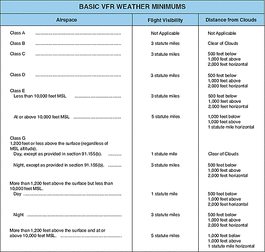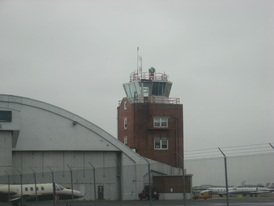The past couple of days, here in the New York metropolitan area, have seen cloudy skies, rain, and overall poor weather. The majority of the time, IFR rules have been in effect. There are two types of flights, and flight plans, which pilots can file; Visual Flight Rules and Instrument Flight rules. It’s important to know the difference between the two. In order for your better understanding, this post will describe what each is and the importance of both.
Stable Vs. Unstable air
First off, most people associate clear skies, warm weather, and clean air as good weather for flying. This isn’t entirely true. While clear skies are positive to flying, they usually indicate unstable air. Unstable air is described as air with the tendency to rise vertically; which can be associated with cumulus clouds, good visibility, showery precipitation and turbulence. Therefore when one looks up and sees bright blue skies, it usually means planes in the air are experiences some degree of turbulence. On the other hand, stable air is much more conducive to peaceful flight. However, in order for air to be stable, air must be the opposite of that which describes unstable air. Stable air does not rise vertically and is associated with stratiform (or layered looking) clouds, poor visibility, steady precipitation, and no turbulence. When you go outside on a day where it’s overcast and has been raining constantly for an extended period of time, the planes in the air feel little turbulence. Unfortunately, they are flying in the clouds and can’t see anything.
Stable Vs. Unstable air
First off, most people associate clear skies, warm weather, and clean air as good weather for flying. This isn’t entirely true. While clear skies are positive to flying, they usually indicate unstable air. Unstable air is described as air with the tendency to rise vertically; which can be associated with cumulus clouds, good visibility, showery precipitation and turbulence. Therefore when one looks up and sees bright blue skies, it usually means planes in the air are experiences some degree of turbulence. On the other hand, stable air is much more conducive to peaceful flight. However, in order for air to be stable, air must be the opposite of that which describes unstable air. Stable air does not rise vertically and is associated with stratiform (or layered looking) clouds, poor visibility, steady precipitation, and no turbulence. When you go outside on a day where it’s overcast and has been raining constantly for an extended period of time, the planes in the air feel little turbulence. Unfortunately, they are flying in the clouds and can’t see anything.

Visual Flight Rules
This brings the discussion to VFR vs. IFR flight. In order to fly VFR, pilots must “play” by certain rules. The FAA defines visual flight rules as “The pilot must be able to operate the aircraft with visual reference to the ground, and by visually avoiding obstructions and other aircraft.” Basically, they rely on sight to fly the plane. The weather minimums, described in the FARs sec. 91.155 state: (a) Except as provided in paragraph (b) of this section and §91.157, no person may operate an aircraft under VFR when the flight visibility is less, or at a distance from clouds that is less, than that prescribed for the corresponding altitude and class of airspace in the following table. The chart to the left (click to enlarge) describes what each airspace’s limitations are for VFR. Because each airspace has its’ own level of air traffic, VFR rules are different for each. If, while flying in the appropriate airspace, a pilot cannot maintain these weather minimums, than he or she will have to file an IFR flight plan, or change course or altitude to stay in VFR flight.
Instrument Flight Rules
If weather falls below these minimums, than a pilot must file an IFR flight plan, prior to departure. The FAA defines IFR flight as “Rules and regulations established by the FAA to govern flight under conditions in which flight by outside visual reference is not safe. IFR flight depends upon flying by reference to instruments in the flight deck, and navigation is accomplished by reference to electronic signals.” This means that if conditions exist below the weather minimums, IFR flights must be flown by reference to the flight instruments, and by electronic signals from the ground, or controlling agencies; tower or ARTCC. The FARs state in sec. 91.167 what the requirements for IFR flights are.
This brings the discussion to VFR vs. IFR flight. In order to fly VFR, pilots must “play” by certain rules. The FAA defines visual flight rules as “The pilot must be able to operate the aircraft with visual reference to the ground, and by visually avoiding obstructions and other aircraft.” Basically, they rely on sight to fly the plane. The weather minimums, described in the FARs sec. 91.155 state: (a) Except as provided in paragraph (b) of this section and §91.157, no person may operate an aircraft under VFR when the flight visibility is less, or at a distance from clouds that is less, than that prescribed for the corresponding altitude and class of airspace in the following table. The chart to the left (click to enlarge) describes what each airspace’s limitations are for VFR. Because each airspace has its’ own level of air traffic, VFR rules are different for each. If, while flying in the appropriate airspace, a pilot cannot maintain these weather minimums, than he or she will have to file an IFR flight plan, or change course or altitude to stay in VFR flight.
Instrument Flight Rules
If weather falls below these minimums, than a pilot must file an IFR flight plan, prior to departure. The FAA defines IFR flight as “Rules and regulations established by the FAA to govern flight under conditions in which flight by outside visual reference is not safe. IFR flight depends upon flying by reference to instruments in the flight deck, and navigation is accomplished by reference to electronic signals.” This means that if conditions exist below the weather minimums, IFR flights must be flown by reference to the flight instruments, and by electronic signals from the ground, or controlling agencies; tower or ARTCC. The FARs state in sec. 91.167 what the requirements for IFR flights are.

Pilots who have not yet received an instrument rating are not permitted to fly IFR. In order to do so, the student pilot must first obtain a private pilot license, then enroll and earn an instrument rating. This course teaches student pilots the operations of instrument flying.
The picture to the left (click to enlarge) shows the former control tower at my base airport, Republic – KFRG. (A new tower on the other side of the field controls all flight activity; however, this tower was used decades ago.) Every towered airport has a rotating beacon, and Republic’s is atop the old tower. The beacon rotates at night, and also during IFR conditions. Also, the rotating beacon identifies which type of airport it’s on. If a beacon flashes a white light, followed by a green light, (you can see in the picture the green light is flashing by) the airport is a land, civil airport. If there is a while signal followed by two green flashes, the airport is a land military airport. When the beacon flashes a white, then yellow light, it’s a sea port; and if the beacon flashes white, green then yellow, the beacon’s located on a helipad.
Knowing the difference between VFR and IFR is important for pilots. Pilots who don’t follow the proper rules are subjected to license revocation, fine, or another form of punishment by the Federal Aviation Administration
The picture to the left (click to enlarge) shows the former control tower at my base airport, Republic – KFRG. (A new tower on the other side of the field controls all flight activity; however, this tower was used decades ago.) Every towered airport has a rotating beacon, and Republic’s is atop the old tower. The beacon rotates at night, and also during IFR conditions. Also, the rotating beacon identifies which type of airport it’s on. If a beacon flashes a white light, followed by a green light, (you can see in the picture the green light is flashing by) the airport is a land, civil airport. If there is a while signal followed by two green flashes, the airport is a land military airport. When the beacon flashes a white, then yellow light, it’s a sea port; and if the beacon flashes white, green then yellow, the beacon’s located on a helipad.
Knowing the difference between VFR and IFR is important for pilots. Pilots who don’t follow the proper rules are subjected to license revocation, fine, or another form of punishment by the Federal Aviation Administration
